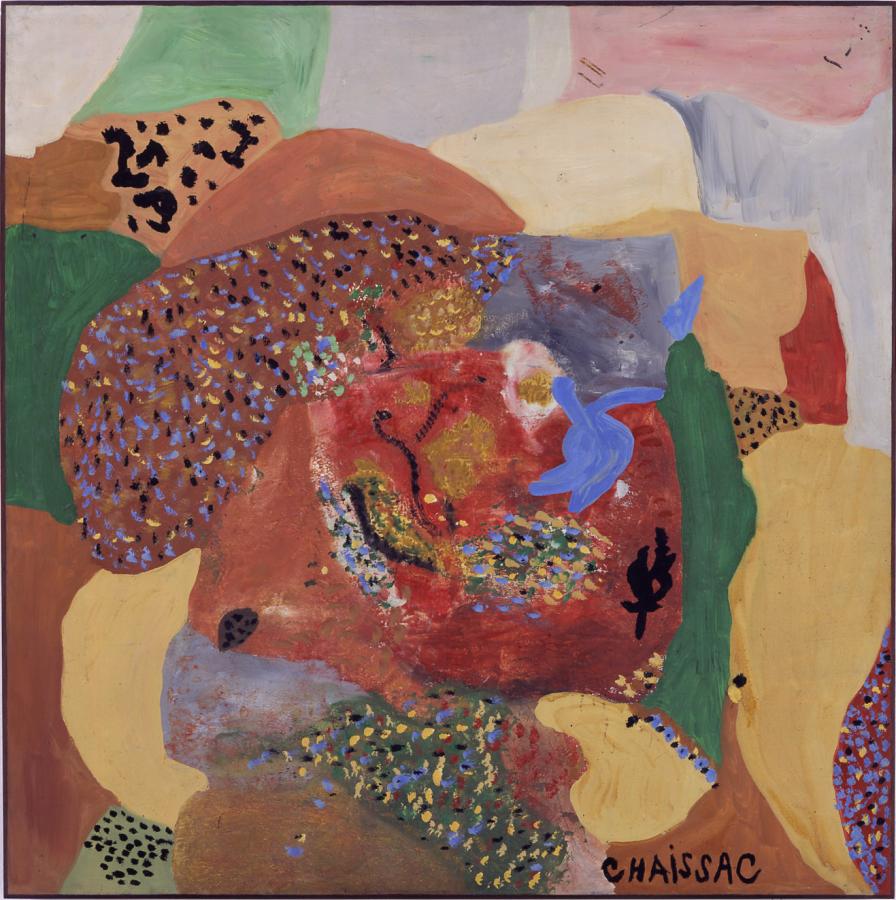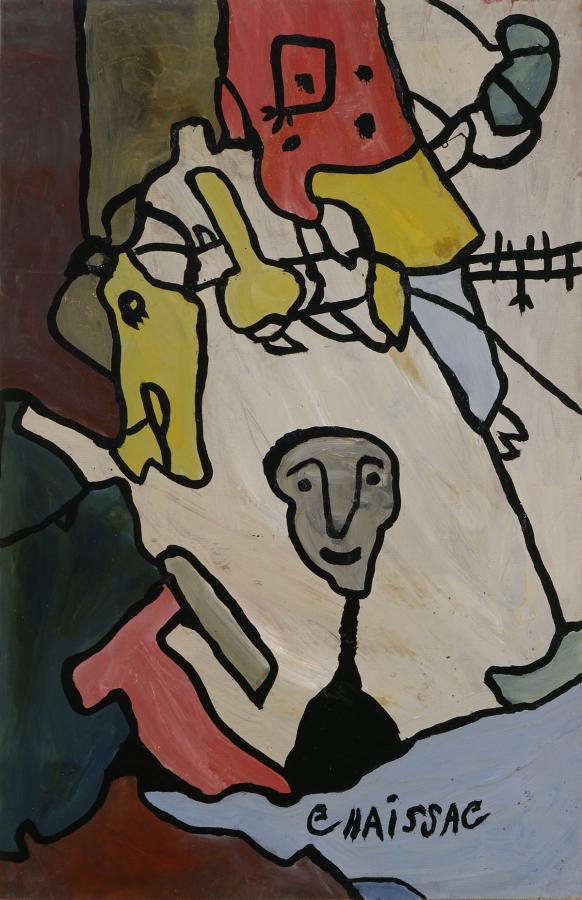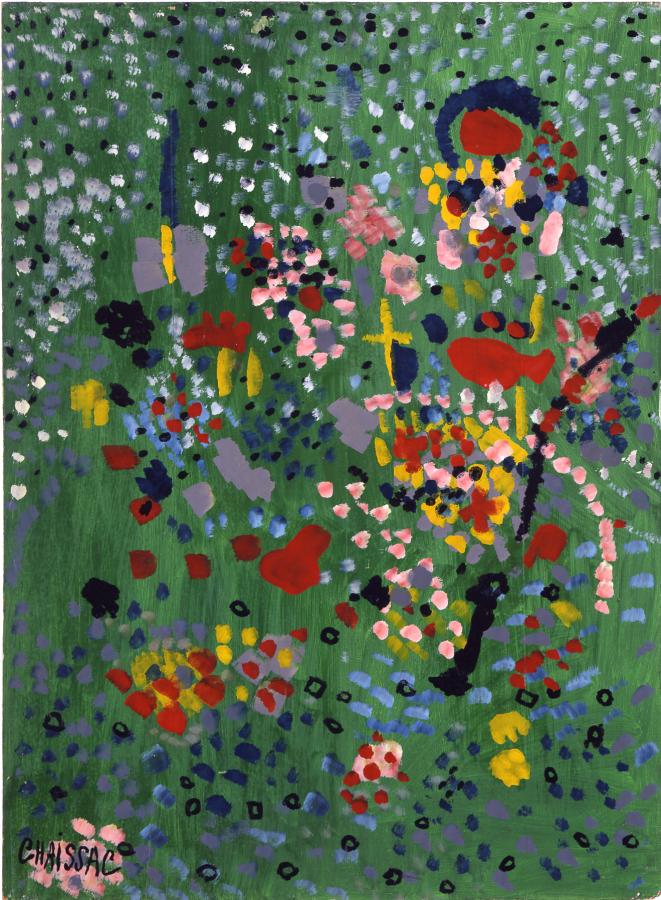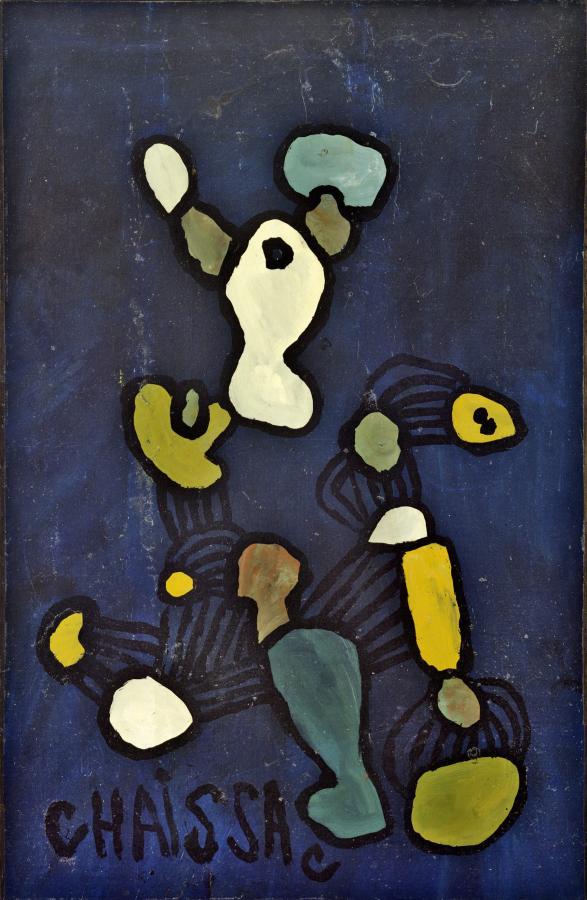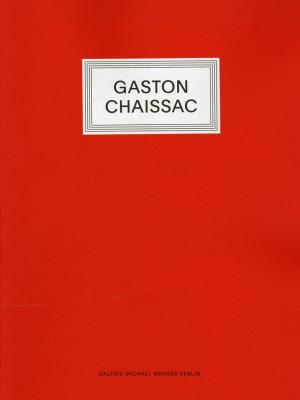Press release
Painter-poet Gaston Chaissac (1910–1964), who also produced countless drawings, skipped the phase of academic learning or self-teaching and quest for discovery in his artistic career. His first steps into fine art in Paris in 1936-7 resemble one of those chance constellations celebrated by the Surrealists. He arrived in the metropolis of Modern art as a day laborer and left it a few months later as its “master”. It was Otto Freundlich who, having established his academy “Le Mur” in the backyard of the house in which Chaissac lived for a short period, accorded him this status. Born and raised in the countryside and uneducated, it appeared the 27-year-old nevertheless had a natural knack for what all artists in Paris sought: the contemporary universal formula for the image. As far as painting was concerned, Chaissac unwaveringly elaborated this colorful pictorial formula to make a firm statement in the following almost 30 years.
In doing so he undermined every category of the Parisian art establishment. Schools, isms, avant-gardes – Chaissac’s clear, simple formula left all the self-proclaimed goals of a developmental history of Modern art behind him as so much pedantic academic painting. Correspondingly vehement was the response. The attempts to both rebuff and appropriate Chaissac suffice to fill their own chapter of art history. Chaissac’s pictorial formula balances the artificial dichotomies of abstraction and objectivity, formalism and figuration so flexibly that Freundlich promptly promoted the younger artist from “master” to “master sorcerer”: “Sorcier Chaissac”. Jean Paulhan’s characterization of Chaissac as “a spontaneous Klee” is just as accurate: Chaissac’s paintings do indeed seem like season tickets to Paul Klee’s unfinished “intermediate realm”.
Despite all areas of Chaissac’s oeuvre having been examined since the 1970s – be it his paintings, painted sculptures, drawings, or poetry (which is at the same time epistolary art) - there is nevertheless still no positive term for his pictorial formula. The artist’s defensive strategy, akin to notorious understatement, had an all too appealing effect in this regard. At the same time, the irony with which he wove the prejudices against his origins into the image of his artistic persona is hard to ignore. If he occasionally articulated rhetorical regret about his calling to visual art (when he realized the hornet’s nest he had put his foot in given the fiercely contested Parisian art scene), he did so to hold a mirror up to it. He veiled his art in the very stereotype that banished him from Paris, namely the artist type of the clochard, the provincial tramp that you would rather not be seen in a café with, presenting himself as a “poète rustique”.
Chaissac dug deep into the primal seedbed of the image once more. Yet instead of exploiting the archaic or some theory in order to do so, as the avant-gardes of the day did, he activated the potential of his home region. It appears his mistake was that he simply did not hail from Tahiti or Easter Island, Byzantium, or outer space, but instead from a French backwater. The man-made landscape of the pastoral “Bocage” is the counterimage to the Modernist metropolis that is Paris. Even if one can sense things Celtic in some of his drawings, this referencing of his home region does not amount to a historicist criterion for style. Rather, a functional visual criterion is rooted in the Bocage that extends through Romanesque architectural sculpture right through to cave painting, which Chaissac got to know early on in life. He did not need to know the Romantic art theories and their ramifications in order to realize that the picture was a form of life, an animated object. Chaissac recognizes that the painting is an organism and lays it bare in his variable pictorial formula.
This corporealization of the image (and often enough a face looks out at us from Chaissac’s paintings, drawings, and even his epistolary poetry) was the drastic, almost blasphemous aspect of his contribution to the Parisian art scene. Chaissac guarded the magical source of the image, and anyone also wanting to access it had to go through him. It is not just in fairytales that this task falls to daring heroes from afar. While from a historical remove the current generation of French painters draws from this source unhindered, for painters from Germany it became a legend much earlier. For in Germany all those similarly versed had been driven out, broken, or, like Freundlich, even murdered. When in the early 1960s painters Eugen Schönebeck and Georg Baselitz traveled to Paris in search of role models to legitimize their own subversion of western abstraction and eastern figuration, it was Chaissac they encountered. The paintings that would go on to make Baselitz famous are a continuation of Chaissac’s pictorial formula. And it is only today, namely through both French and German theory being able to construe the image as a life form, that Chaissac’s work can finally be appreciated for what it represents: the founding statutes of a cheerful cult of the image that puts any doomsday scenario to one side.
